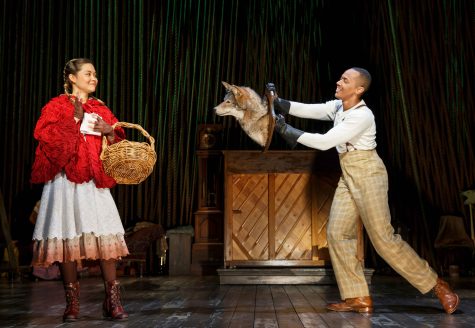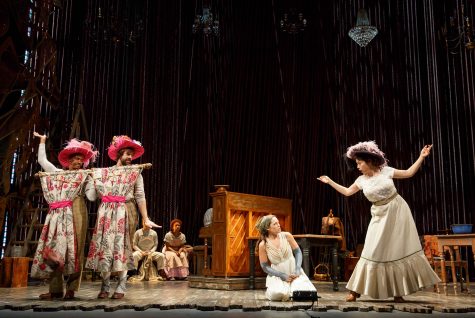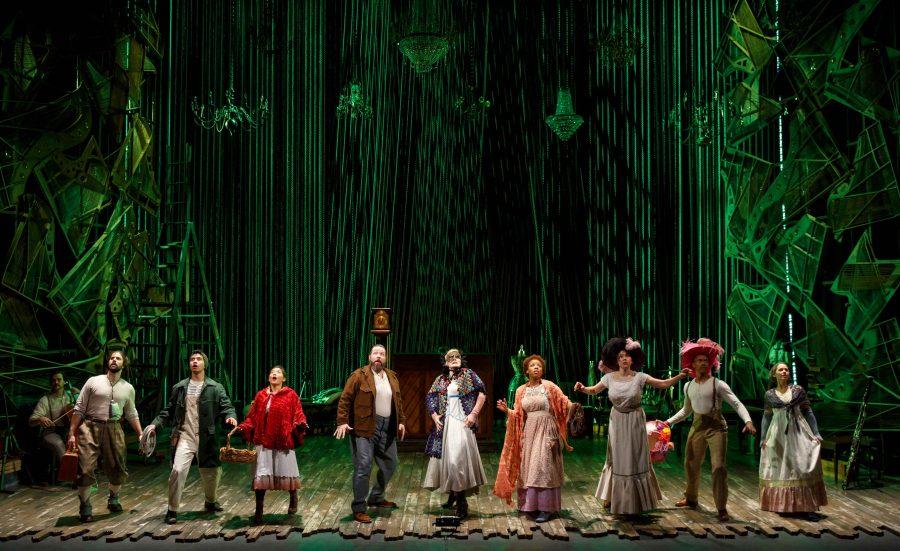Fiasco Theater’s ‘Into the Woods:’ a fresh take on a classic show
Courtesy of Playhouse Square and Joan Marcus
The company of Fiasco Theater’s “Into the Woods.”
For any musical theatre fan, Stephen Sondheim’s “Into the Woods” is a staple. The original Broadway cast is legendary, and the cast album is sure to be downloaded on any theatre fan’s iPhone. With such a classic show, I was surprised when the Fiasco Theater production, which opened Off-Broadway in January 2015, earned such rave reviews from the media and die hard theatre fans alike. Luckily, I was given a chance to form my own opinion of this new re-imagined production when the show’s national tour opened in Cleveland on Jan. 10.
Fiasco Theater simplified and created a different “Into the Woods” than many people have seen in the past. Between the minimalistic costumes, set, casting and accompaniment, Fiasco took the grandeur of the classic productions of “Into The Woods,” and put the focus back on Sondheim’s complicated, yet beautiful, music and lyrics.
The way the magical elements of the show were portrayed with everyday objects forced the performers to put the magic of the show into their acting and mannerisms. My favorite use of this technique was with Anthony Chatmon II. Chatmon played the Wolf among other roles, and did a fantastic job of representing the characteristics of a wolf using only a mounted wolf head and his own body and voice.

Anthony Chatmon II as the Wolf and Lisa Helming Johanson as Little Red Ridinghood.
The set, which ironically included zero trees, was beautiful in a very mechanical and industrial way. The back wall of the theater was covered with several levels of diagonally strung rope organized to look like the strings of a grand piano. The strings created a backdrop, an entrance way and a facilitator for the disappearance of some of the characters. The side of the stage was also adorned with the functional parts of grand pianos. The minimalistic costumes also brought the focus back on the text and music, but it was hard to decipher who was who at some points in the show.
The minimalist casting choices also created issues for the clarity of the story. Many actors played more than one part, some playing two characters who interacted with one another. I understand that the creative team doubled characters to create a more ensemble cast, but the same faces in similar costumes was immensely confusing at points in the plot where many characters were involved.
The orchestral score of “Into the Woods,” and Sondheim musicals in general, is known across the musical theatre world as being lush, full and incredibly intricate. This production boiled the layered accompaniment into one upright piano, a cymbal, a bassoon and a few children’s instruments, all played by members of the ensemble with the exception of the piano played by the expressive Evan Rees. As a fan of Sondheim’s complicated scores this was a little bit of a disappointment. The huge orchestras are a defining part of what makes Sondheim so special, and taking that away fundamentally changed the nature of the work.
Despite what I felt about the production elements of the show, the cast’s performances were impeccable. Laurie Veldheer was adorable as the indecisive Cinderella, showcasing strong vocals all throughout her range. Veldheer also played double duty as Little Red Riding Hood’s Granny, proving her impressive range. Evan Harrington and Eleasha Gamble played the Baker and the Baker’s Wife respectively. Their portrayal was exactly what I wanted: solid vocals, definitive acting and the ability to create conflict for the audience through their imperfect characters. As much as the audience wants to hate the Baker’s Wife for what she does, Gamble made the audience understand the motivation behind her decision.

Laurie Veldheer as Cinderella, Bonnie Kramer as Cinderella’s Stepmother and Anthony Chatmon II and Darick Pead as Lucina and Florida respectively featuring the minimalistic costumes of Fiasco’s “Into the Woods.”
I was most impressed with Darick Pead who played Milky White (Jack’s cow), Florinda (Cinderella’s stepsister) and Rapunzel’s Prince. Pead added a new life to Milky White, a character who doesn’t speak or sing at all, which I hadn’t seen in other productions. Having a live person play the role instead of a robot, scenic piece or computer graphics, added a level of comedy to the dark show, not to mention the fact that a female cow was played by a large man with a beard. Pead was hilarious and made the scenes with just Jack and Milky White much more interesting than those adaptations that took another route with the role through his physical comedy skills, vocalization and facial expressions.
Stephanie Umoh as the Witch was somewhat of a miss for me. Although I loved her voice, I didn’t get the creepiness or the unexpectedness that is a staple in the Witch’s character. Whether that was due to the lack of special effects or due to Umoh’s performance, I couldn’t tell, but something felt off about her treatment of the Baker and the Baker’s wife. She wasn’t as intimidating to them, and I felt their reactions to her were blown out of proportion based on what was put on the table. That being said, her performance of “Last Midnight” and her disappearance into the ropes upstage were perfectly unsettling.
At the end of Fiasco’s “Into the Woods,” I found myself very conflicted. There were parts of the show that I loved, and there were parts of the show that I couldn’t justify. Theatre is always changing and evolving, which is one of the things I love about it, and it’s always great to see a fresh take on beloved material. As Sondheim said: “I firmly believe lyrics have to breathe and give the audience’s ear a chance to understand what’s going on. Particularly in the theater, where you have costume, story, acting, orchestra,” which is what I think this production did so well. Despite its confusing elements, Fiasco brought the focus back to Sondheim’s incredible lyrics, which redeemed it in the long run.











![Spider webs, signs, ghosts and different types of candy are examples of how a trunk could be decorated to interest the children participating in Trunk or Treat. “I plan on decorating [my car] with fun spider webs and playing fun Halloween music,” Kurilenko said. Graphic made by Aleah Rothstein.](https://theSHSCourier.com/wp-content/uploads/2025/10/unnamed-2025-10-21T145747.705.png)